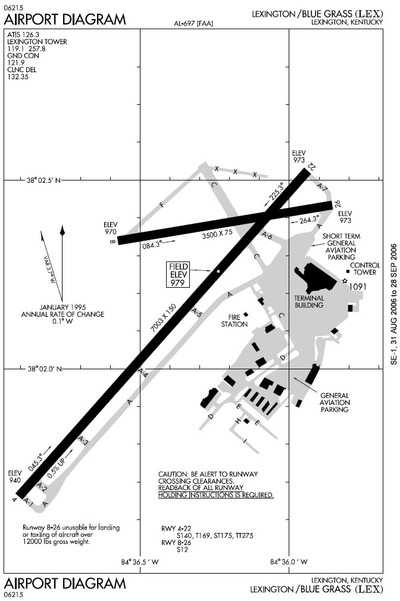Wed, Dec 13, 2006
Cites No Crew Coordination Of Runway After Takeoff
Clearance
 Based on last summer's accident
involving Comair flight 5191, and five other previous accidents
and/or incidents of crews using the wrong runway for take off, the
NTSB has issued specific recommendations to amend FAR Part 121
rules.
Based on last summer's accident
involving Comair flight 5191, and five other previous accidents
and/or incidents of crews using the wrong runway for take off, the
NTSB has issued specific recommendations to amend FAR Part 121
rules.
The NTSB's recommendation amounts to a formal request for the
FAA to mandate all Part 121 operators "...establish procedures
requiring crewmembers on the flight deck to positively confirm and
cross-check the airplane’s location at the assigned departure
runway before crossing the hold-short line for takeoff."
The FAA's (non-mandatory) Advisory Circular (AC) 120-74A from
September 2003 already suggests, "Before entering a runway for
takeoff, the flightcrew should verbally coordinate to ensure
correct identification of the runway and receipt of the proper ATC
clearance to use it." The NTSB's recommendation asks the FAA to
make the suggestions in AC 120-74A mandatory.
Runway 26 at Lexington Blue Grass Airport was not lighted
the morning Comair's flight 5191 crashed. The plane's CVR
recorded the pilots' comments on the lack of edge lighting even as
they initiated the take off from the too-short runway. As a result,
the NTSB has further requested the FAA to "...require all [Part
121] operators provide specific guidance to pilots on the runway
lighting requirements for takeoff operations at night."
The NTSB cited several similar past occurrences of crews using
the wrong runway. Among them, two incidents at Houston's William P.
Hobby Airport where crews used Runway 17 instead of 12R as cleared.
In both instances the aircraft struck barriers on the closed
runway, but were able to continue on to their destinations. As a
result of those incidents, the majority of US-based carriers
adopted NTSB recommendations for pilots to cross-check heading
indicators after lining up for take off on the runway. In fact, the
pilots of Comair's flight 5191 both had heading bugs set for a
departure on Runway 22.

The NTSB isn't the first safety agency to suggest verbal
confirmation of runway selection between pilots prior to take off.
In October 2000 a Singapore Airlines 747 attempted to take off from
a runway under construction at Taiwan's Chiang Kai-Shek
International. That crash killed 83 people and prompted a
recommendation from Taiwan's Aviation Safety Council that Singapore
Airlines "include in all company pre-takeoff checklists an item
formally requiring positive visual identification and confirmation
of the correct takeoff runway."
The NTSB says it queried NASA's Aviation Safety Reporting System
and found 114 incidents of pilots using the wrong runway for take
off between March 1988 and September 2005.
More News
Airbus Racer Demonstrator Makes Inaugural Flight Airbus Helicopters' ambitious Racer demonstrator has achieved its inaugural flight as part of the Clean Sky 2 initiative, a corners>[...]
A little Bit Quieter, Said Testers, But in the End it's Still a DA40 Diamond Aircraft recently completed a little pilot project with Lufthansa Aviation Training, putting a pair of >[...]
Line Up And Wait (LUAW) Used by ATC to inform a pilot to taxi onto the departure runway to line up and wait. It is not authorization for takeoff. It is used when takeoff clearance >[...]
Contributing To The Accident Was The Pilot’s Use Of Methamphetamine... Analysis: The pilot departed on a local flight to perform low-altitude maneuvers in a nearby desert val>[...]
From 2015 (YouTube Version): Overcoming Obstacles To Achieve Their Dreams… At EAA AirVenture 2015, FedEx arrived with one of their Airbus freight-hauling aircraft and placed>[...]
 Airbus Racer Helicopter Demonstrator First Flight Part of Clean Sky 2 Initiative
Airbus Racer Helicopter Demonstrator First Flight Part of Clean Sky 2 Initiative Diamond's Electric DA40 Finds Fans at Dübendorf
Diamond's Electric DA40 Finds Fans at Dübendorf ANN's Daily Aero-Term (04.23.24): Line Up And Wait (LUAW)
ANN's Daily Aero-Term (04.23.24): Line Up And Wait (LUAW) NTSB Final Report: Extra Flugzeugbau GMBH EA300/L
NTSB Final Report: Extra Flugzeugbau GMBH EA300/L Classic Aero-TV: 'Never Give Up' - Advice From Two of FedEx's Female Captains
Classic Aero-TV: 'Never Give Up' - Advice From Two of FedEx's Female Captains




